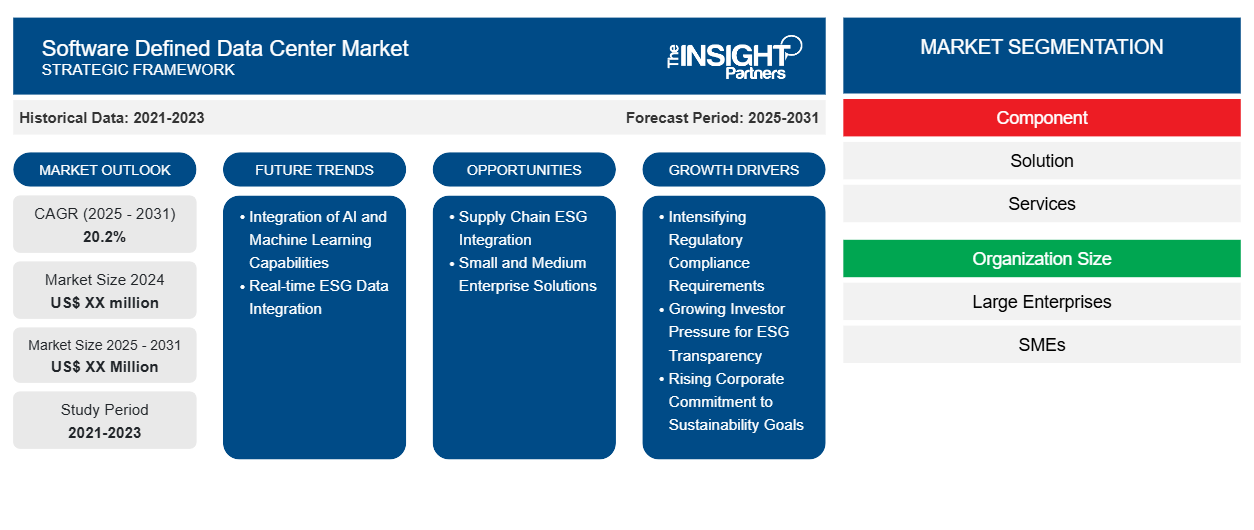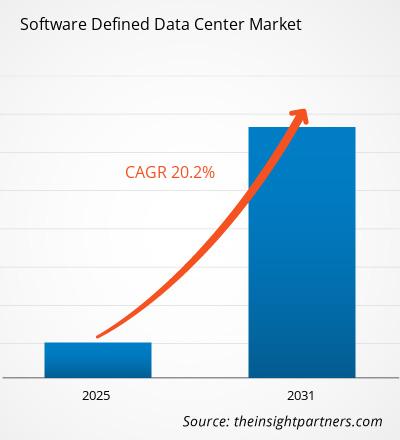Für den Markt für softwaredefinierte Rechenzentren wird von 2025 bis 2031 eine durchschnittliche jährliche Wachstumsrate (CAGR) von 20,2 % erwartet, wobei die Marktgröße von XX Millionen US-Dollar im Jahr 2024 auf XX Millionen US-Dollar im Jahr 2031 anwachsen wird.
Der Bericht ist segmentiert nach Komponenten (Lösungen, Services), Unternehmensgröße (Großunternehmen, KMU) und Endnutzern (Unternehmen, Telekommunikationsdienstleister, Cloud-Dienstleister, Managed Service Provider). Die globale Analyse wird weiter nach Regionen und Ländern aufgeschlüsselt. Der Bericht bietet den Wert in USD für die oben genannten Analysen und Segmente.
Zweck des Berichts
Der Bericht „Software Defined Data Center Market“ von The Insight Partners beschreibt die aktuelle Marktsituation und das zukünftige Wachstum sowie die wichtigsten Treiber, Herausforderungen und Chancen. Er liefert Einblicke für verschiedene Geschäftsinteressenten, wie zum Beispiel:
- Technologieanbieter/-hersteller: Um die sich entwickelnde Marktdynamik zu verstehen und die potenziellen Wachstumschancen zu kennen, können sie fundierte strategische Entscheidungen treffen.
- Investoren: Durchführung einer umfassenden Trendanalyse hinsichtlich der Marktwachstumsrate, der finanziellen Marktprognosen und der Chancen entlang der Wertschöpfungskette.
- Regulierungsbehörden: Sie regulieren die Richtlinien und polizeilichen Aktivitäten auf dem Markt mit dem Ziel, Missbrauch zu minimieren, das Vertrauen der Anleger zu wahren und die Integrität und Stabilität des Marktes aufrechtzuerhalten.
Marktsegmentierung für softwaredefinierte Rechenzentren
Komponente
- Lösung
- Leistungen
Unternehmensgröße
- Große Unternehmen
- KMU
Endbenutzer
- Unternehmen
- Telekommunikationsdienstleister
- Cloud-Dienstanbieter
- Managed Service Provider
Geographie
- Nordamerika
- Europa
- Asien-Pazifik
- Naher Osten und Afrika
- Süd- und Mittelamerika
Sie erhalten kostenlos Anpassungen an jedem Bericht, einschließlich Teilen dieses Berichts oder einer Analyse auf Länderebene, eines Excel-Datenpakets sowie tolle Angebote und Rabatte für Start-ups und Universitäten.
Markt für softwaredefinierte Rechenzentren: Strategische Einblicke

- Holen Sie sich die wichtigsten Markttrends aus diesem Bericht.Dieses KOSTENLOSE Beispiel umfasst Datenanalysen, die von Markttrends bis hin zu Schätzungen und Prognosen reichen.
Wachstumstreiber für den Markt für softwaredefinierte Rechenzentren
- Steigende regulatorische Compliance-Anforderungen: Die globale Regulierungslandschaft für ESG-Reporting wird zunehmend komplexer und strenger. Neue Vorschriften wie die CSRD der EU, die Offenlegungsregeln der SEC zum Klimawandel und verschiedene nationale Mandate zwingen Unternehmen zur Einführung anspruchsvoller Reporting-Lösungen. ESG-Reporting-Software bietet automatisierte Compliance-Prüfungen, standardisierte Rahmenbedingungen und revisionssichere Dokumentation, um diesen wachsenden Anforderungen gerecht zu werden. Die Fähigkeit der Software, mehrere Reporting-Standards gleichzeitig zu verfolgen und gleichzeitig Datengenauigkeit und -konsistenz über verschiedene Rechtsräume hinweg sicherzustellen, macht sie für Unternehmen, die in unterschiedlichen regulatorischen Umgebungen tätig sind, unverzichtbar.
- Steigender Druck von Investoren hinsichtlich Transparenz im ESG-Bereich: Institutionelle Investoren und Stakeholder fordern mehr Transparenz und Detailliertheit bei ESG-Offenlegungen. Unternehmen benötigen robuste Softwarelösungen zur Erfassung, Überprüfung und Berichterstattung von ESG-Kennzahlen, die den Sorgfaltspflichten der Investoren gerecht werden. Die Software ermöglicht Unternehmen, detaillierte Daten zur Nachhaltigkeitsleistung, Wirkungsanalysen und Fortschrittsverfolgungen im Hinblick auf ESG-Ziele bereitzustellen. Diese Fähigkeit ist insbesondere für börsennotierte Unternehmen und Unternehmen, die eine nachhaltige Finanzierung anstreben, von entscheidender Bedeutung, da Investoren die ESG-Performance zunehmend in ihre Investitionsentscheidungen einbeziehen.
- Steigendes Engagement von Unternehmen für Nachhaltigkeitsziele: Unternehmen setzen sich ehrgeizige Nachhaltigkeitsziele und benötigen ausgefeilte Tools, um ihre Fortschritte zu verfolgen und zu dokumentieren. ESG-Reporting-Software ermöglicht die Echtzeitüberwachung von Umweltauswirkungen, sozialen Initiativen und Governance-Praktiken. Diese Plattformen ermöglichen es Unternehmen, CO2-Emissionen zu messen, den Ressourcenverbrauch zu verfolgen, die Nachhaltigkeit der Lieferkette zu überwachen und Kennzahlen zu sozialen Auswirkungen zu bewerten. Die Analysefunktionen der Software helfen Unternehmen, Verbesserungspotenziale zu identifizieren und konkrete Fortschritte bei der Erreichung ihrer Nachhaltigkeitsverpflichtungen nachzuweisen.
Zukünftige Trends im Markt für softwaredefinierte Rechenzentren
- Integration von KI und maschinellem Lernen: ESG-Reporting-Plattformen integrieren zunehmend KI und maschinelles Lernen, um die Datenerfassung, -analyse und -berichterstattung zu verbessern. Diese Technologien ermöglichen die automatisierte Datenextraktion aus verschiedenen Quellen, die Erkennung von Anomalien in ESG-Kennzahlen und prädiktive Analysen zur Nachhaltigkeitsleistung. KI-gestützte Funktionen helfen Unternehmen, Trends zu erkennen, Auswirkungen vorherzusagen und präzisere Nachhaltigkeitsberichte zu erstellen. Gleichzeitig reduzieren sie manuellen Aufwand und potenzielle menschliche Fehler.
- Echtzeit-ESG-Datenintegration: Der Markt verlagert sich hin zu Echtzeit-ESG-Datenerfassungs- und -Berichtsfunktionen. Unternehmen fordern Plattformen, die ESG-Kennzahlen kontinuierlich überwachen und aktualisieren können, anstatt sich auf regelmäßige manuelle Aktualisierungen zu verlassen. Dieser Trend wird durch die Notwendigkeit zeitnaherer Entscheidungen und Stakeholder-Kommunikation hinsichtlich der ESG-Performance vorangetrieben. Echtzeit-Monitoring ermöglicht die sofortige Identifizierung von Problemen und eine schnellere Reaktion auf Nachhaltigkeitsherausforderungen.
Marktchancen für softwaredefinierte Rechenzentren
- ESG-Integration in der Lieferkette: ESG-Reporting-Software bietet erhebliches Potenzial für die Überwachung der Nachhaltigkeit in der Lieferkette. Unternehmen benötigen Tools, um die ESG-Leistung ihrer Lieferanten zu verfolgen und darüber zu berichten und so die Einhaltung von Nachhaltigkeitsstandards entlang der gesamten Wertschöpfungskette sicherzustellen. Softwareplattformen können Lieferantenbewertungen erleichtern, Nachhaltigkeitszertifizierungen überwachen und ESG-Daten im gesamten Liefernetzwerk aggregieren. Dies ermöglicht eine umfassende Berichterstattung über Scope-3-Emissionen und andere indirekte Auswirkungen.
- Lösungen für kleine und mittlere Unternehmen: Der KMU-Bereich bietet wachsende Chancen für vereinfachte, kostengünstige ESG-Reporting-Lösungen. Da die Anforderungen an die Nachhaltigkeitsberichterstattung auch auf kleinere Unternehmen ausgeweitet werden, steigt die Nachfrage nach optimierten Plattformen, die grundlegende Berichtsfunktionen bieten, ohne die Komplexität von Unternehmenslösungen zu erfordern. Softwareanbieter können spezialisierte Angebote entwickeln, die KMU dabei unterstützen, grundlegende Berichtsanforderungen zu erfüllen und gleichzeitig kostengünstig zu bleiben.
Regionale Einblicke in den Markt für softwaredefinierte Rechenzentren
Die Analysten von The Insight Partners haben die regionalen Trends und Faktoren, die den Markt für softwaredefinierte Rechenzentren im Prognosezeitraum beeinflussen, ausführlich erläutert. In diesem Abschnitt werden auch die Marktsegmente und die geografische Lage für softwaredefinierte Rechenzentren in Nordamerika, Europa, im asiatisch-pazifischen Raum, im Nahen Osten und Afrika sowie in Süd- und Mittelamerika erläutert.
Umfang des Marktberichts über softwaredefinierte Rechenzentren
| Berichtsattribut | Details |
|---|---|
| Marktgröße im Jahr 2024 | XX Millionen US-Dollar |
| Marktgröße bis 2031 | XX Millionen US-Dollar |
| Globale CAGR (2025 – 2031) | 20,2 % |
| Historische Daten | 2021–2023 |
| Prognosezeitraum | 2025–2031 |
| Abgedeckte Segmente | Nach Komponente
|
| Abgedeckte Regionen und Länder | Nordamerika
|
| Marktführer und wichtige Unternehmensprofile |
|
Marktdichte von Software Defined Data Centern: Auswirkungen auf die Geschäftsdynamik verstehen
Der Markt für softwaredefinierte Rechenzentren wächst rasant. Die steigende Nachfrage der Endnutzer ist auf Faktoren wie veränderte Verbraucherpräferenzen, technologische Fortschritte und ein stärkeres Bewusstsein für die Produktvorteile zurückzuführen. Mit der steigenden Nachfrage erweitern Unternehmen ihr Angebot, entwickeln Innovationen, um den Bedürfnissen der Verbraucher gerecht zu werden, und nutzen neue Trends, was das Marktwachstum weiter ankurbelt.

- Verschaffen Sie sich einen Überblick über die wichtigsten Akteure auf dem Markt für softwaredefinierte Rechenzentren
Wichtige Verkaufsargumente
- Umfassende Abdeckung: Der Bericht deckt die Analyse von Produkten, Diensten, Typen und Endbenutzern des Marktes für softwaredefinierte Rechenzentren umfassend ab und bietet eine ganzheitliche Landschaft.
- Expertenanalyse: Der Bericht basiert auf dem umfassenden Verständnis von Branchenexperten und Analysten.
- Aktuelle Informationen: Der Bericht gewährleistet Geschäftsrelevanz durch die Berichterstattung über aktuelle Informationen und Datentrends.
- Anpassungsoptionen: Dieser Bericht kann angepasst werden, um den spezifischen Kundenanforderungen gerecht zu werden und die Geschäftsstrategien optimal zu unterstützen.
Der Forschungsbericht zum Markt für softwaredefinierte Rechenzentren kann daher dazu beitragen, die Branchensituation und die Wachstumsaussichten zu entschlüsseln und zu verstehen. Obwohl es einige berechtigte Bedenken geben mag, überwiegen die Vorteile dieses Berichts tendenziell die Nachteile.
- Historische Analyse (2 Jahre), Basisjahr, Prognose (7 Jahre) mit CAGR
- PEST- und SWOT-Analyse
- Marktgröße Wert/Volumen – Global, Regional, Land
- Branchen- und Wettbewerbslandschaft
- Excel-Datensatz
Aktuelle Berichte
Erfahrungsberichte
Grund zum Kauf
- Fundierte Entscheidungsfindung
- Marktdynamik verstehen
- Wettbewerbsanalyse
- Kundeneinblicke
- Marktprognosen
- Risikominimierung
- Strategische Planung
- Investitionsbegründung
- Identifizierung neuer Märkte
- Verbesserung von Marketingstrategien
- Steigerung der Betriebseffizienz
- Anpassung an regulatorische Trends




















 Kostenlose Probe anfordern für - Markt für softwaredefinierte Rechenzentren
Kostenlose Probe anfordern für - Markt für softwaredefinierte Rechenzentren